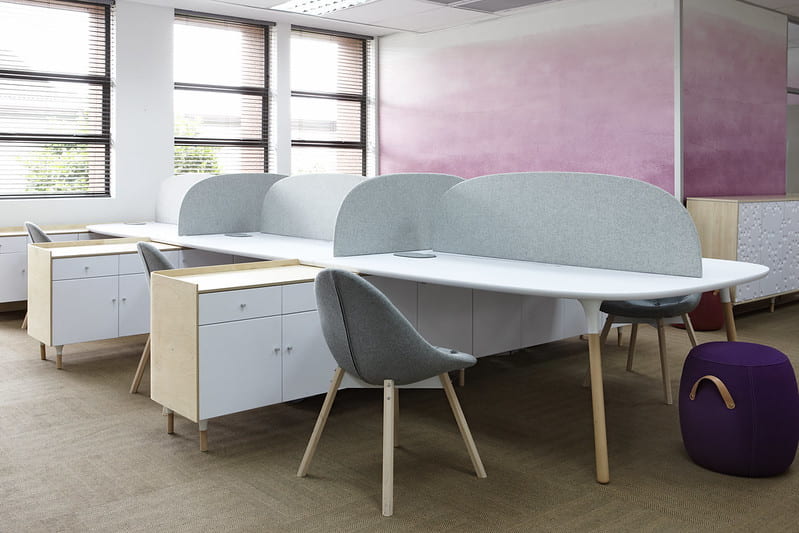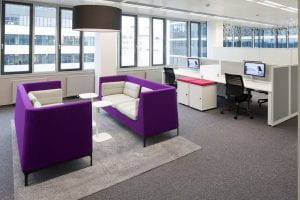This post follows on from ‘‘The office is not obsolete, maybe the system is”, thinking about hybrid working and the return to the office for staff at City, University of London, and what that might look like

A paraphrased review of an article by C.Whitman
‘A Look into The Workplace Post-COVID-19
Over the past decade, workplace design has witnessed a move away from cellular and reserved workplaces into an open and communal environment. Businesses have been able to draw in the finest and smartest of staff by moving to more loose and dynamic offices, the inverse of conventional workspaces that are planned to cultivate more collaborative and inventive work. Sometimes known as the “anti-office” it’s the most recent trend of work environment plan, but how will it adapt now given the current pandemic?
With the Covid-19 virus many are anxious about going back into their open workplaces and are told that workplaces must return to a more segregated and secure space. Installing self-contained pods and Perspex screens might provide some reassurances immediately, but in the future, staff have said and will want opportunities for social interaction and group work. Most of us have become accustomed to working at home, so making staff feel confident enough to go back on site is a mammoth task for businesses. Our work environment needs to be centered on wellness.
The Evolution of the “Anti-Office”
Over the past year, there has been a seismic change in thinking, where individuals are generally reluctant to commute into the office, mainly because of the time and cost of our journeys and concerns about the cleanliness of public transport with the risks of overcrowding. There is a widely held view that we are more productive working from home too. Another reason that we are reluctant to go back into the office is the increasing emphasis on our wellbeing. People may well consider others less hygienic and less observant and more casual with health and safety measures. Workplace design needs to reflect on an all-encompassing wellness methodology. The primary step to accomplishing this objective is to see how we work change. We require our workplaces to replicate the same wellbeing measures that we as individuals expect from our fellow worker.

Implementing Wellness Aspects
Facilities managers should provide more automated technology to reduce the amount of contact surfaces that we are exposed to on our way in and out of the workplace. Individuals will need to do away with touching surfaces as we have done on public transport and communal areas. As buildings effect new wellbeing measures and guidance for open and common areas, the occupants must follow these new benchmarks, or they will not be permitted to gain access to the workplace. Office proprietors must overhaul Building Management Systems such as HVAC with suitable filtration, as well as investing in new cleaning regimes that will mark secure spaces for office workers and guarantee their health and wellbeing is key.
Individuals will only feel easier about going back to their workplaces if given a sense of safety and an avoiding the worst of the exterior world. This can be accomplished by deliberately fitting furniture and accessories that give a warm and welcoming atmosphere. There may be an increase in the application of antimicrobial surfaces in office redesigns, hopefully not where the offices become sterile with silver metal finishes. Natural materials such as wood and stones have been proven to reduce the growth of bacteria and viruses. Through the integration of natural components and colour palettes that are to quote the recent design term, ‘biophilic’, workplaces can give the impression of calm and security, providing shelter for staff from the outside.
It is logical for cleaning purposes to keep desks tidy and less cluttered, staff well-being is negatively impacted if managers do not allow people to personalise their workplace. By letting people add personal touches to the office, they will appreciate a greater sense of belonging and by that process, feel more connected to the business and to their colleagues.

Adjusting to Lower Occupancy
The biggest change within the working environment will be the how and when we work. For the past year, managers and their workforce have demonstrated that they can work and collaborate viably from home. Despite changes in the workplace, some people will still feel uncomfortable travelling back into the office full time. Expectations are that workplaces may witness a 50% reduction in occupancy. To change for this, office design should install touchdown areas. These spaces would be comparable to single phone booths, but slightly bigger to suit one or two individuals. Touchdown spaces in the workplace may resemble contemporary furniture showrooms. So instead of having a desk that’s only in use half of the week, making hot-desking areas might encourage staff to go into the office on certain days that they choose, with a place to work, without the unnecessary situation of banks of empty desks.
Alternatively, organisations could do away with personal desks completely. Therefore, the workplace could be designed again like a furniture showroom, but lockers provided for each person. There would be less hot-desking, and more of a range of furniture types and layouts to choose from. While this “hoteling” model isn’t new, workplaces could provide more variety; with tables, standing desks, phone rooms, small booths or pods, touchdown rooms, soft seating, and more sociable open areas. At the close of each day, individual possessions can effectively be put back into their locker. This framework would permit for simple cleaning and secure personal items such as keyboards, laptops and the office mug.
The Covid-19 pandemic has brought about the potential for huge changes to workplace design, a paradigm shift. We are social animals and ned to get away from the office to connect and collaborate with other people, whilst feeling secure and healthy. Being able to travel into the office that is adaptable and accepting of individuals’ choice and needs for comfort will be fundamentally to staff well-being from now and into the future. It may well mean that may the workplace needs to be restructured so that no one is closer than 2 meters to each other, or the consequence is that most staff continue to work remotely. Either way, staff wellbeing is the key to the future.
Paraphrased by James Rutherford
https://www.workdesign.com/2020/06/a-look-into-the-workplace-post-covid-19-the-anti-office/

At one of my previous workplaces, hot desking was the norm. Some people had lockers, but others had under-desk drawer units that could be rolled from desk to desk. As they all had straps to drag them around, it used to look like my colleagues were taking their filing cabinets for a walk.